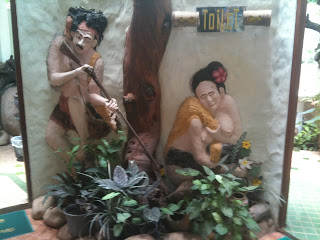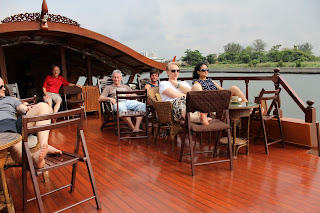After dealing with a jungle thunderstorm that temporarily cut off power at Northern Thailand's
Pang-Soon Lodge - a torrential downpour that threatened to curtail our scheduled activities - when the sun started to come out at mind-morning, we thought nothing could daunt us.
Wrong.
We headed out for an afternoon nature hike along the Mae Lai River. It started with a bit of a tough uphill stretch, but soon we were strolling past vast groves of bamboo, vanilla trees, tea and numerous coffee trees. The terrain began to change, sending us back and forth across the river along narrow wooden bridges and up and down mossy stone steps cut into the rock.

Several beautiful waterfalls of various sizes highlighted the path, and when we got to the grandaddy of the falls, we did have the option of swimming in the river at the foot of the falls. Not a bad idea, considering how hot and humid we'd become during our 45-minute trek up to the falls.
Until the leeches showed up.
They weren't bi g- but they were insidious, and the little black,worm-like creepy-crawlies seemed to be everywhere. I was the last one in our group to get to the falls, and as I was approaching the edge of the bank, everyone else was rushing the other way, beating a hasty retreat away from the falls.
"Leeches!" came the cry.
One of the ladies in our group showed me one of the little parasites on her leg. Meanwhile, our lead guide was encouraging me to step out onto the rocks in the river to get a good angle for a photo of the falls.
"What the heck," I thought. "I don't see any leeches lurking about on the rocks, the leech didn't look
that big - and I'll only be a few minutes."
So out I walked, to shoot some photos and video of the falls.
Several minutes later, my mission accomplished, I made my way back to the shore. That's when the assistant guide pointed down at my crotch.
There was something small and dark, wiggling around (and
no, I had
not accidentally left my fly open!)
It was a leech, hanging on to the front of my pants, looking to gain access to my skin, so it could attach itself and start sucking (my
blood, people, my blood!)
I quickly flicked it off, then did a hasty survey. There didn't seem to be any more of his disgusting little playmates on me, so off I went, trudging back down the path.
 |
Belly button courtesy of Norah Murphy;
leech courtesy of nature.
(Photo by Laura Byrne Paquet) |
I took my time heading back, stopping to shoot several photos along the way. At one point, I was passed by two of the ladies in our group, who had been behind me. They were practically running down the trail, and only took time to mutter something like, "Leeches! Gross!"
I continued to saunter along the path, taking photos.
When I got back to the lodge, the staff told me to stop and put my gear down. A bit perplexed, I did as I was bid - then figured out why they told me to do that.
It was time for a leech inspection.
They found seven on me, mainly on my socks and pants, (which were tucked into my pants, thankfully). They sprayed them with what can only be described as "leech-off." If sprayed on the leeches vigorously enough, they would curl up and eventually fall off.
After that, I headed straight for the shower and while stripping off my T-shirt, found one final determined leech stuck to the inside of my shirt. It took quite a big of convincing (it really was a determined little blood-sucker!) but eventually I managed to get him off my shirt and into the toilet which I flushed quickly and with no small amount of satisfaction.

Then into the shower I jumped. I don't think I ever washed so thoroughly in my life, especially given the fact it was a essentially a cold shower (this is a jungle lodge, after all).
It turns out, I got off easy. Everyone else in our group had at least one leech on their skin, including one lady who had it attached to her bell button. (Shades of
Alien!)
While it wasn't quite as bad as Humphrey Bogart's leech scene in
The African Queen, my leech experience certainly didn't leave me thirsty for more.
I loved the hike, the scenery and the sounds and smells of the jungle.
But I think next time I hike in this area, I'll make sure to bring some of that leech-off. Or at least a large shaker of table salt.
































